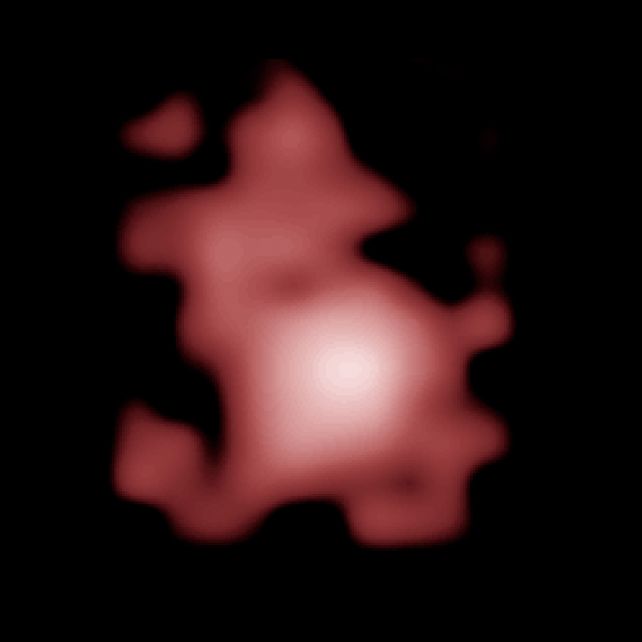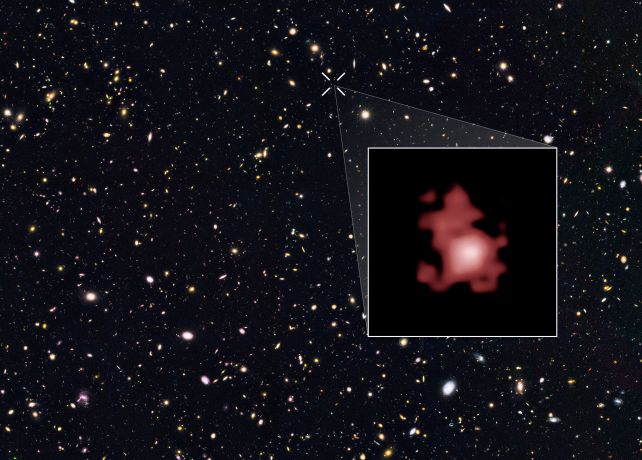Discovery of the Earliest Observed Black Hole at the Beginning of the Universe
The earliest black hole ever observed is emitting a faint glimmer across the vast expanse of time and space. This glimmer, detected by a team led by astrophysicist Roberto Maiolino of the University of Cambridge, originates from the host galaxy of the black hole as it inexorably spirals towards the event horizon. Remarkably, this black hole, which appeared just 400 million years after the Big Bang, is already of immense size, boasting a mass approximately 1.6 million times that of the Sun.
This groundbreaking discovery provides support for the direct collapse model of supermassive black hole formation in the early Universe, as opposed to the gradual process of accretion from a massive star. According to Maiolino, the presence of such a massive black hole at such an early stage in the Universe prompts us to explore alternative theories of their formation.
During the early stages of the Universe, galaxies were abundant in gas, making them an abundant source of sustenance for black holes. This further reinforces the notion that these early galaxies served as a veritable buffet for these cosmic entities.

The galaxy in question, known as GN-z11, has been previously observed. It was first identified several years ago through observations made by the Hubble telescope, making it the earliest galaxy ever seen in the Universe. The light from GN-z11 has traveled for 13.4 billion years to reach us, considering that the Big Bang occurred approximately 13.8 billion years ago. Although this record has been surpassed by the James Webb Space Telescope (JWST), GN-z11 still holds significance.
The JWST was launched after the discovery of GN-z11 and offers an unprecedented level of sensitivity, allowing for a more detailed examination of the distant Universe. Dr. Maiolino and his team utilized this new space telescope to obtain a closer look at GN-z11, surpassing the capabilities of the Hubble telescope and uncovering what lies at the core of this distant galaxy.
Through the JWST observations, the researchers were able to analyze the spectrum emitted by GN-z11. This analysis revealed the presence of accretion, which is the process by which black holes consume matter.
Black holes are known for their inability to produce light. Once matter reaches a certain distance from the black hole’s center, known as the event horizon, the gravitational pull becomes so strong that light cannot escape. However, outside the event horizon, matter swirls and agitates in the extreme environment surrounding the black hole, forming a disk that feeds into it.
This accretion disk emits an intense amount of light, as it is heated by gravity and friction, overpowering the light emitted by the galaxy itself. The researchers concluded that this is the source of the illumination observed in GN-z11.
Interestingly, the black hole in GN-z11 is consuming matter at an exceptionally rapid rate. This accelerated feeding is likely to extinguish the young galaxy, as the black hole begins to emit powerful nuclear winds. These winds will eventually disperse all the gas necessary for star formation within the galaxy, resulting in a tranquil object drifting through space, with very few new stars being formed.
Researchers believe that GN-z11, a tiny galaxy, is approximately 100 times smaller than our own Milky Way. The black hole within this galaxy seems to be consuming gas at a rapid pace, which could result in the gas being expelled into intergalactic space. Consequently, this expulsion would hinder the black hole’s growth as it disperses any potential “food” material.

The formation of the black hole, due to its immense size, is unlikely to have originated from a star-sized object within the 400 million years since the Big Bang. However, it can be included in the category of black holes formed through the gravitational collapse of massive clusters of matter during the early stages of the Universe. Considering that black holes are commonly found at the center of galaxies, it is reasonable to assume that any galaxies observed earlier with the JWST will also possess black holes.
Nevertheless, GN-z11 stands as the earliest confirmed and measured galaxy, existing during the Epoch of Reionization, which marks the dawn of the Universe. Prior to this period, space was opaque, only becoming transparent and allowing the free flow of light as matter underwent reionization.
The origin of the ionizing radiation remains a significant question in cosmology. GN-z11 suggests that black holes played a role in this process.
According to the researchers, GN-z11 is the first hyperluminous galaxy in the early Universe to be spectroscopically confirmed and subjected to a detailed spectroscopic analysis. They state in their paper that the active galactic nucleus scenario, as revealed by their analysis, offers a natural explanation for the extraordinary luminosity of GN-z11. If this scenario is representative of the broader class of luminous galaxies discovered by the JWST in the early Universe, it would alleviate the tension with existing models and simulations, potentially indicating a more prominent role of active galactic nuclei in the reionization of the Universe.
The research has been published in Nature.
Do not forget to share your opinion with us to provide you with the best posts !



0 Comments